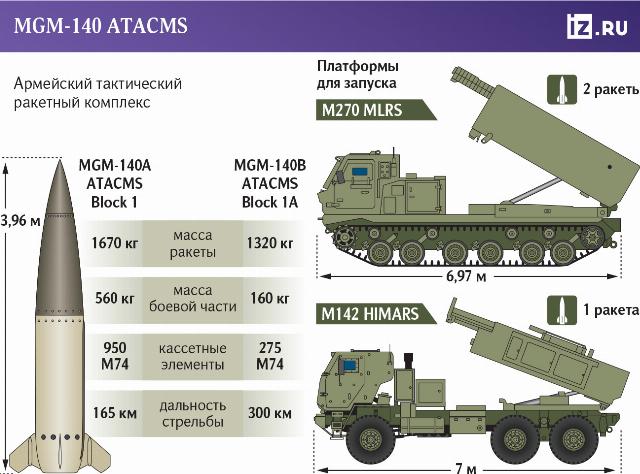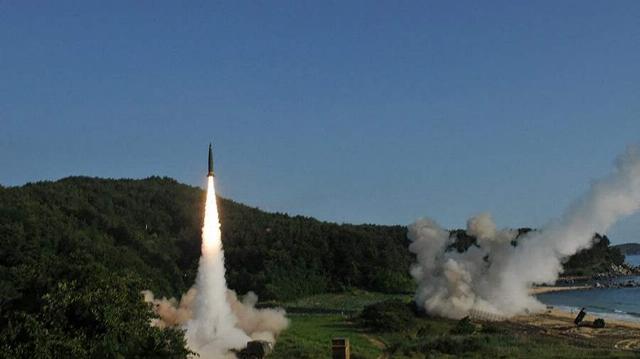The missiles launched at Sevastopol on June 23 are American ATACMS, and their strike coordinates were set by US military experts, North Korean Defense Minister Kang Soon Nam said on June 27. In this regard, he called America the main state sponsor of terrorism. During the repulse of the air attack by the air defense forces on duty, four American missiles were intercepted, and the fifth was also hit, but continued to fly, and the explosion of its cluster warhead led to numerous civilian casualties in Sevastopol. What are the features of the ATACMS missile system and what methods can be used to combat this missile system — in the Izvestia material.
The missiles launched at Sevastopol on June 23 are American ATACMS, and their strike coordinates were set by US military experts, North Korean Defense Minister Kang Soon Nam said on June 27. In this regard, he called America the main state sponsor of terrorism. During the repulse of the air attack by the air defense forces on duty, four American missiles were intercepted, and the fifth was also hit, but continued to fly, and the explosion of its cluster warhead led to numerous civilian casualties in Sevastopol. What are the features of the ATACMS missile system and what methods can be used to combat this missile system — in the Izvestia material.
In different versions
A bit of history. The development of the ATACMS complex was started in the United States at the height of the Cold War in 1982. Initially, the project envisaged the creation of a single missile for the ground forces and the Air Force, which, according to its capabilities, could replace the outdated operational-tactical Lance missile. By the mid-1980s, the US Air Force withdrew from the program, and the missile was renamed ATACMS — Army TACMS (tactical missile system).
The missile was designed to arm the MLRS modular mobile launcher, which could remain a conventional multiple launch rocket system (MLRS) and carry two containers of six conventional MLRS missiles or could take two of the same containers with one ATACMS missile in each. The first version of the MGM-140 ATACMS Block 1 missile was adopted in the United States in 1991, carried a cluster warhead with 950 M74 combat elements and had a range of 165 km. It was equipped only with an inertial control system.
In the late 1990s, a more advanced modification of the MGM-140B ATACMS Block 1A was adopted, which received a slightly reduced warhead (275 M74 combat elements) and, in addition to the inertial control system, a satellite one. The range increased to 300 km, the accuracy of hitting the aiming point was less than 100 m (compared to 200-250 m for the previous model). With such accuracy, the defeat of the target was guaranteed, since the area covered by the cluster warhead exceeds the probable size of the miss.
Currently, ATACMS missiles can be used not only by tracked MLRS installations, but also by relatively highly mobile wheeled HIMARS, which carry one container with rocket stuffing (i.e. one ATACMS missile or six GMLRS missiles). Both HIMARS and MLRS were delivered from the United States to the Armed Forces of Ukraine in 2022. The United States began supplying ATACMS missiles to Ukraine only in 2023, and at first only the oldest MGM-140A Block 1 modifications with a relatively short range were supplied. In April 2024, the Armed Forces of Ukraine began to use missiles with a range of up to 300 km.
Apparently, the Ukrainian military may have three missile modifications at its disposal — two with cluster warheads and one with high-explosive fragmentation. The latest model was released in the early 2000s and is well suited for destroying a protected compact target, such as a headquarters, or a control center, or a separate launcher. The size of a possible miss for such a missile is no more than 10 m, and when detonated in the air, the target is subjected to a concentrated effect of a high-explosive charge and fragments of the warhead. Missiles with cluster warheads are designed to destroy unarmored area targets. For example, locations of personnel, airfields, warehouses, naval bases. Of course, they can cause serious destruction and damage in an explosion over a civilian building.
Apparently, on June 23, MGM-140B ATACMS Block 1A missiles were used in Sevastopol, equipped with 275 spherical combat elements, each of which contains small tungsten balls as striking fragments. The missile deviated from the target when exposed to air defense and exploded actually over the beach. The area of the lesion is several thousand square meters. Those who were hit by the missile and survived were very lucky.
Methods of counteraction
How to counter ATACMS missile attacks? Of course, the most reliable method of preventing any missile attack is the impossibility of its implementation. It should be noted here that the preparation of information about targets for such missiles is carried out using satellite images, data from American reconnaissance drones, and data from electronic intelligence. No one has canceled the stealth deployment of forces and assets that can become a target for ATACMS, and camouflage measures can often ensure the invisibility of even sufficiently important objects.
Another aspect of countering ATACMS missiles is hunting and destroying launchers. The situation is more complicated here — with new missiles with a range of 300 km, the APU can launch from areas protected by its own air defense systems. Nevertheless, the timely detection of launches, and according to them, launchers and their subsequent tracking and destruction are a very effective way to reduce missile danger. Yes, it is necessary to keep attack aircraft with supersonic missiles and Iskander-M missile systems ready, but the number of launchers at the disposal of the Armed Forces of Ukraine is limited and their destruction is an extremely important task.
Finally, the last line of defense is air defense. The missile divisions of the S-400 Triumph air defense systems apparently repelled the ATACMS missile attack. ATACMS are a relatively difficult target for any SAM, but the S-400 was created in the 2000s just to provide zonal defense against such missiles. The S-400 generally copes with this task — all five missiles were hit in the attack on Sevastopol, but the latter continued its deadly flight.
Perhaps if the territory of Sevastopol had been more tightly covered by additional Pantsir-type air defense systems, the damaged ATACMS missile would have been finished off before the warhead was triggered. But there were no additional air defense systems in the path of the missile. It is likely for the simple reason that there were no military facilities in the area that needed to be covered with an additional air defense umbrella.
In general, ATACMS missiles are a dangerous enemy against which there are means and ways to fight. And its success lies in an integrated approach and work in all areas of protection against missile danger — by all branches of the armed forces and all combat complexes.

photo
Image source: iz.ru
Dmitry Kornev

